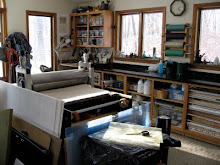I've been playing around with various ideas for an upcoming group portfolio for The Printmakers' Network of Southern New England.
http://www.printmakersnetwork.org This will be our seventh group project and one with interesting parameters. We're calling it
Print Cubed.
 |
| Mock up and film positives. |
The idea is to create an edition of 35 prints that will be presented in 6" X 6" cubes. The twist however is that each individual print will measure 6" X 18"; the images will need to be folded to fit into the cube. Each printmaker has the option of either creating three individual, but related images, on the long narrow sheet or one continuous image. When completed, each participating artist will receive a portfolio, with a few extras available for sale.
I've always looked forward to participating in these group projects. This one in particular is intriguing and I welcome the challenge of trying to create one continuous image that will lend itself to being folded.
After a lot of frustrating stops and starts trying to find
the perfect
subject matter, it occurred to me that this accordion format was
reminiscent of a length of folded fabric; a logical analogy for someone
who's been sewing all her life.
An old corset became my jumping off point because like the folded paper, a corset is compact until stretched out. I did a number of planning sketches, photographed the corset, used Photo Shop to extract various sections, then reassembled the pieces to fit the page to my liking.
I soon realized that it was necessary to create a mock-up of the imagined print because I needed to see where the folds would land. To reinforce the fabric theme, I'm considering breaking down the image
into thirds so I can print the sections individually and then
machine-stitch them together to create the full 18 inch print. I'll need to plan carefully for the overlapping to avoid the folds.
 |
| Mock-up of front and back of proposed print. |
Another consideration is whether or not to print on the back side of the paper using
one of my body print images. I'll wait and see what develops but at this stage
"Second Skin" seems to be off to a decent start.























